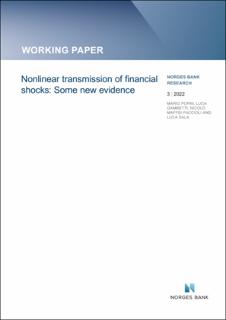| dc.contributor.author | Forni, Mario | |
| dc.contributor.author | Gambetti, Luca | |
| dc.contributor.author | Maffei-Faccioli, Nicolò | |
| dc.contributor.author | Sala, Luca | |
| dc.date.accessioned | 2022-06-03T10:54:35Z | |
| dc.date.available | 2022-06-03T10:54:35Z | |
| dc.date.issued | 2022 | |
| dc.identifier.isbn | 978-82-8379-225-6 | |
| dc.identifier.issn | 1502-8190 | |
| dc.identifier.uri | https://hdl.handle.net/11250/2997495 | |
| dc.description.abstract | Financial shocks generate a protracted and quantitatively important effect on real economic activity and financial markets only if the shocks are both negative and large. Otherwise, their role is quite modest. Financial shocks have become more important for economic fluctuations after the 2000 and have contributed substantially to deepening the recessions of 2001 and 2008. The evidence is obtained using a new econometric procedure based on a Vector Moving Average representation that includes a nonlinear function of the financial shock. | en_US |
| dc.language.iso | eng | en_US |
| dc.publisher | Norges Bank | en_US |
| dc.relation.ispartofseries | Working paper;3/2022 | |
| dc.rights | Attribution-NonCommercial-NoDerivatives 4.0 Internasjonal | * |
| dc.rights.uri | http://creativecommons.org/licenses/by-nc-nd/4.0/deed.no | * |
| dc.subject | JEL: C32 | en_US |
| dc.subject | JEL: E32 | en_US |
| dc.subject | SVAR | en_US |
| dc.subject | financial shocks | en_US |
| dc.subject | non-linearity | en_US |
| dc.subject | asymmetry | en_US |
| dc.subject | financial crisis | en_US |
| dc.title | Nonlinear transmission of financial shocks: Some new evidence | en_US |
| dc.type | Working paper | en_US |
| dc.description.version | publishedVersion | en_US |
| dc.subject.nsi | VDP::Samfunnsvitenskap: 200::Økonomi: 210::Samfunnsøkonomi: 212 | en_US |
| dc.source.pagenumber | 46 | en_US |

